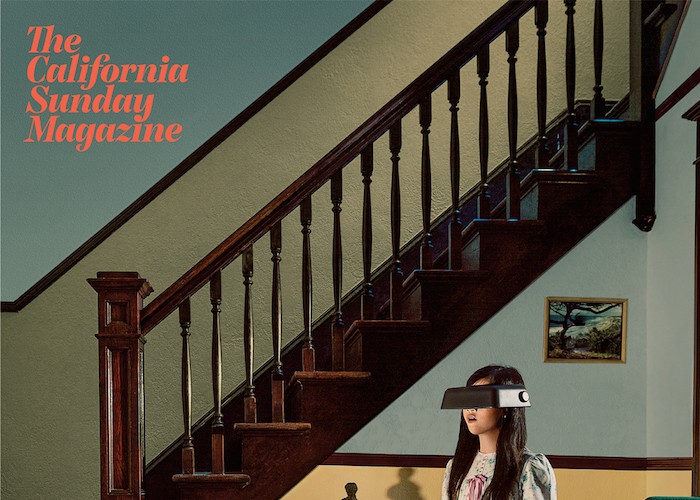
California Sunday Magazine, which launched conceptually in January and physically earlier this month, was beloved before its first issue was even printed. The magazine, a project of Douglas McGray’s, is available both in print and online, on tablet and mobile, and aims to tell beautiful, reported stories about the American West, Latin America, and Asia.

“As Pop-Up Magazine grew, it started to seem strange to me that California and the West Coast — and wider West — didn’t have anything like an eclectic, general-interest, big-audience title,” says McGray. “If something like that were going to exist, the community around Pop-Up Magazine would be ideal.”
Part of Pop-Up’s success, according to McGray, is that it capitalizes on a desire for a lean-back media experience — it’s held at night and the audience often gathers at a bar after the event. “We spend so much time scanning media at our desks, it’s hard to pay attention,” McGray says. “We’re distracted.” He predicted that a digital and print product that arrived only on the weekend would also fit this leisure-time niche.
Based on initial reactions to the magazine, he seems to be on to something.
This story in @CalSunday is unreal. Incredible reporting. https://t.co/IVVimeArS5 #longreads
— michelle buchman (@michelledeidre) October 7, 2014
Today is Monday, but the @CalSunday website is still relentlessly good: https://t.co/jjYcg5l68y
— mat honan (@mat) October 7, 2014
.@CalSunday magazine is here, and it's a beaut. http://t.co/7xTnNXOTso
— Vauhini Vara (@vauhinivara) October 3, 2014
But beyond elegant design and talented writers, what sets California Sunday apart from the digital magazine crowd is its distribution model. In its first weekend, the print magazine reached 400,000 Californians at home as an insert in the Sunday paper. Just like an advertiser would, the magazine paid the newspapers — the Los Angeles Times, The Sacramento Bee, and the San Francisco Chronicle — to include the print edition with Sunday’s delivery.
“We were going through a business channel they already had,” says McGray. “We’re using it a bit differently, but they liked the way we were intending to use it.”
Not every Sunday newspaper subscriber gets a copy of the magazine. McGray and his team targeted neighborhoods they thought would match their demographic. The magazine’s publisher, Chas Edwards, says he worked with the newspapers to help locate readers who would be most interested in what the magazine has to offer.
“When we started working with newspapers, their thinking was we’d want to reach the most upscale, wealthy readers,” he says. “We don’t necessarily think that audience will be most interested in the magazine. We had to work a little harder to find an audience of people that tend to be younger, live in more urban areas than suburban areas, tend to be more comfortable with technology products.”
Still, it’s not exactly a struggling crowd they’re targeting. Here’s how it describes its audience to potential advertisers:
They are the readers who live in and around the state’s metro centers, especially in neighborhoods populated by residents who over-index on basic demographic attributes (household income, education levels, and spending on domestic travel), as well as characteristics that suggest out-sized cultural influence. For example, they are 50% more likely to read Wired, Vanity Fair, the New Yorker, and the Sunday New York Times than average residents of the LA, SF and Sacramento DMAs. They’re roughly 75% more likely to own a MacBook Pro and drive a hybrid car. They’re almost 100% more likely to spend at least $3,000 per year traveling overseas. Professionally they are developers, designers, writers, entrepreneurs, do-gooders, artists, and media producers.
Because of their considerable circulation at launch, McGray says, they were able to go after national advertisers like Lexus and Nest. Because they have an in-house creative studio available to build campaigns for these brands, they’re also able to charge premium prices. Those advertisers, in turn, mean the magazine can pay for reported features that a smaller publication couldn’t afford.
“There are some things about print that are really good as a business. There are some things that are really tough,” says McGray. “The money you have to spend to build circulation and acquire subscribers to the point where you have a kind of circulation where you can talk to national advertisers…we’ve cut out that part of the print business.”The other piece of the revenue pie for California Sunday is memberships, which are offered in tiers. If you want a copy of the print magazine but don’t live in the delivery zone, you can pay $99.98 a year to become a Superfan, which gets you the print magazine, access to apps and a “limited-edition mystery object designed by California Sunday creative director Leo Jung.” There’s also a $1,299.99 a year option for Patrons, limited to 25, who get reserved Pop-Up Magazine tickets, and a $39.99 a year option for Fans who just want digital access. (Without a subscription, you’ll be subject to the tyranny of a metered paywall.) There’s also an option to fund a project — for between $.99 and $9.99 a month, you can support coverage of education, environment, health, or “inequality and opportunity.”
Though the launch is big in terms of audience, on the production side McGray is scaling up more gradually. The magazine has fewer than 15 full-time staffers, and for now the actual writing will be done entirely by freelancers. Similarly, in the beginning, issues will be released monthly, though McGray says frequency will increase down the line. It’s an interesting strategy that balances a splashy launch — lots of readers and big advertisers — with a cautious plan for scaling that focuses on sustainability and longevity.
“We call it the California Sunday Magazine. You don’t name something that if you expected to do something cool for two years and run out of money, or find it’s not sustainable,” he says. “It’s going to be an institution. It’s going to be around for a long time, make a contribution, be part of civic life.”